|
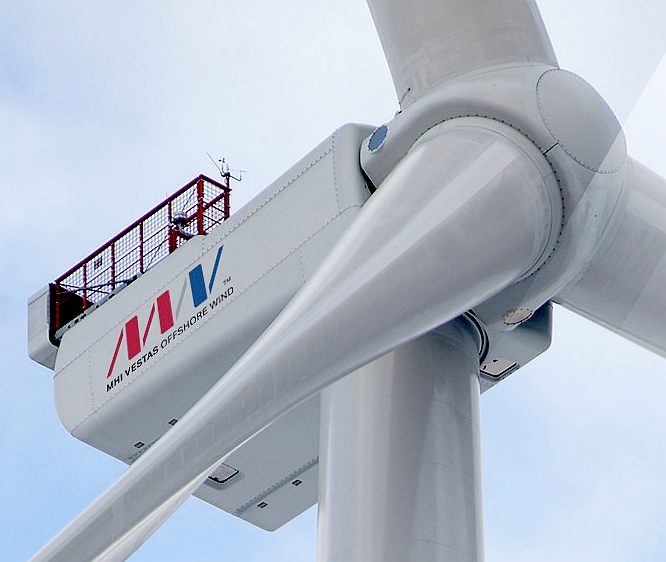
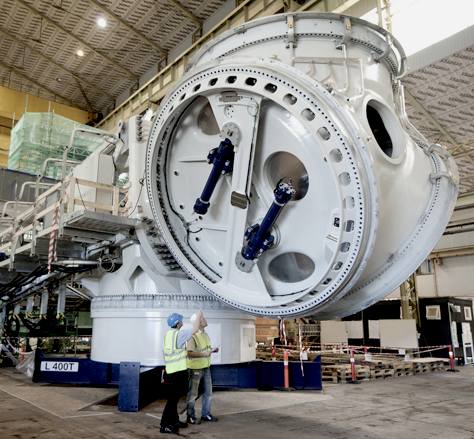
NEW
WORLD RECORD - The Vestus V164-8.0 MW® IEC S is designed from a power plant perspective, helping to drive
the profitability of wind farm operators to new levels. The ratio between the 164 m rotor and the 8.0 MW generator is designed to suit the harsh conditions in the
North Sea area resulting in greater annual energy production. With this rotor-generator ratio, fewer turbines are needed to produce the required amount of energy – reducing the cost of transportation, foundations, installation, cabling, service and maintenance. With its 25-year structural design life, the V164-8.0 MW® is designed to require as little maintenance as possible, and when servicing is required, it is safe, quick and cost efficient.
This record breaking wind turbine signifies a quantum leap forward in rotor size and energy capture. Reducing operations and maintenance costs by enabling customers to run fewer, larger turbines, the 164 m rotor diameters offers you a swept area of more than 21,000 m2, equivalent to almost three football pitches. When it comes to profitability, the bigger the swept area the bigger the revenue.
NOV
24 2014 - VESTAS 8MW PROTOTYPE UNDERGOING TESTS IN DENMARK Development of large custom built offshore wind turbines has taken a step forward with MHI Vestas’ 8MW prototype turbine breaking the world record for wind energy production in a 24 hour period.
Denmark is an ideal country to take a look at the earliest examples of offshore wind turbines and their steady progress since. One of the country’s first project was Vindeby, commissioned in 1991 with the deployment of eleven 450kW turbines, modest to say the least by today’s standards. In 2003 the Frederikshavn windfarm comprised a mix of 2.3MW and 3MW Nordex, Vestas and Bonus (Siemens) turbines. In the subsequent period Vestas (now MHI Vestas) and Siemens have largely dominated the offshore turbine market, 3MW and 3.6MW models from each company respectively becoming particularly popular at European sites.
As of July 2014 there were 2,304 turbines fully grid-connected in European waters with a combined capacity of 7,343MW equating to an average turbine size of just over 3MW. Considerable technological experience has naturally been accrued since and most major turbine manufacturers are now developing larger models intended to reap the benefits of larger windfarms further offshore in more productive (windier) locations.
The European windfarm market has dominated global offshore developments and if markets beyond Europe take off, turbine manufacturers could see new models above 5MW capacity being the entry level standard as the with the 2.3MW versions at the industry’s birth with subsequent huge potential.
The MHI Vestas V164-8.0 MW prototype was installed and commissioned in January 2014 at the Østerild test site in northern Denmark (owned by Denmark’s Technical University) and is currently undergoing testing. The world record for power production by a wind turbine in a 24 hour period was broken early in October when the 8MW turbine produced 192,000 kW/h during steady wind conditions. The power produced by the turbine in one day was enough to supply the energy needs of approximately 13,500 Danish households, roughly equivalent to Thisted; a city close to the test centre.
The turbine is understandably larger than earlier variants. The three blades are each 80m in length, with a swept area of 21,124m2, larger than the London Eye. The nacelle is 24m long, 12m wide and 7.5m high and weighs in at approximately 390 tonnes. The hub height of the Østerild prototype is 140m and tip height 220m: the normal heights in service are quoted as 105m and 187m respectively.
MHI Vestas Offshore Wind’s CEO Jens Tommerup said the record demonstrates the full capacity of the V164-8.0 MW adding: “[the turbine] has been operating with over 90% availability. Our main focus now is continuing to document the performance of the turbine to measure the power curve and the power quality in order to receive type certification.”
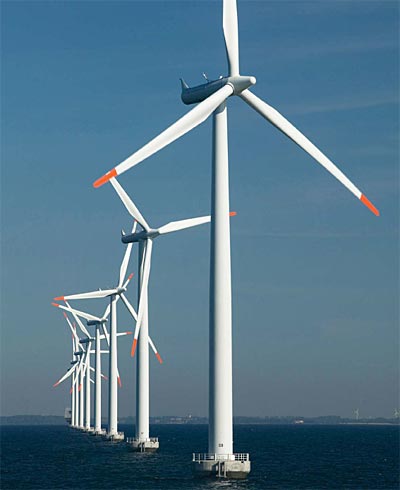
AUGUST
2013
Offshore wind power refers to the construction of wind farms in bodies of water to generate electricity from wind. Better wind speeds are available offshore compared to on land, so offshore wind power’s contribution in terms of electricity supplied is higher, and NIMBY opposition to construction is usually much weaker. However, offshore wind farms are relatively expensive.
As of 2010 Siemens and Vestas were turbine suppliers for 90% of offshore wind power, while Dong Energy, Vattenfall and E.on were the leading offshore operators. As of October 2010, 3.16 GW of offshore wind power capacity was operational, mainly in Northern Europe. According to BTM Consult, more than 16 GW of additional capacity will be installed before the end of 2014 and the United Kingdom and Germany will become the two leading markets. Offshore wind power capacity is expected to reach a total of 75 GW worldwide by 2020, with significant contributions from China and the United States.
As of 2013, the 630 MW London Array is the largest offshore wind farm in the world, with the 504 MW Greater Gabbard wind farm as the second largest, followed by the 367 MW Walney Wind Farm. All are off the coast of the UK. These projects will be dwarfed by subsequent wind farms that are in the pipeline, including Dogger Bank at 9,000 MW, Norfolk Bank (7,200 MW), and Irish Sea (4,200 MW).
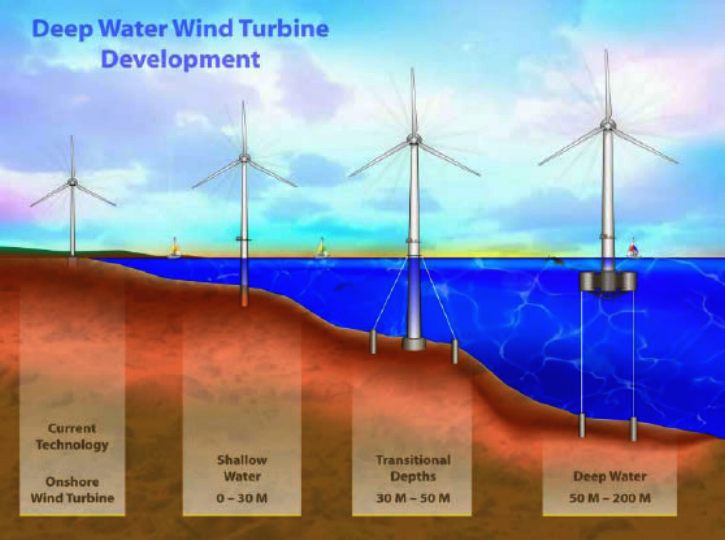
ECONOMIC
BENEFITS
Offshore wind power can help to reduce energy imports, reduce air pollution and greenhouse gases (by displacing fossil-fuel power generation), meet renewable electricity standards, and create jobs and local business opportunities. However, according to the US Energy Information Agency, offshore wind power is the most expensive energy generating technology being considered for large scale deployment". The advantage is that the wind is much stronger off the coasts, and unlike wind over the continent, offshore breezes can be strong in the afternoon, matching the time when people are using the most electricity. Offshore turbines can also be "located close to the power-hungry populations along the coasts, eliminating the need for new overland transmission lines".
Most entities and individuals active in offshore wind power believe that prices of electricity will grow significantly from 2009, as global efforts to reduce carbon emissions come into effect. BTM expects cost per kWh to fall from 2014, and that the resource will always be more than adequate in the three areas Europe, United States and China.
The current state of offshore wind power presents economic challenges significantly greater than onshore systems - prices can be in the range of 2.5-3.0 million Euro/MW. The turbine represents just one third to one half of costs in offshore projects today, the rest comes from infrastructure, maintenance, and oversight. Larger turbines with increased energy capture make more economic sense due to the extra infrastructure in offshore systems. Additionally, there are currently no rigorous simulation models of external effects on offshore wind farms, such as boundary layer stability effects and wake effects. This causes difficulties in predicting performance accurately, a critical shortcoming in financing billion-dollar offshore facilities. A report from a coalition of researchers from universities, industry, and government, lays out several things needed in order to bring the costs down and make offshore wind more economically viable:
* Improving wind performance models, including how design conditions and the wind resource are influenced by the
presence of other wind farms.
* Reducing the weight of turbine materials
* Eliminating problematic gearboxes
* Turbine load-mitigation controls and strategies
* Turbine and rotor designs to minimize hurricane and typhoon damage
* Economic modeling and optimization of costs of the overall wind farm system, including installation, operations, and
maintenance
* Service methodologies, remote monitoring, and diagnostics.
In 2011, a Danish energy company claimed that offshore wind turbines are not yet competitive with fossil fuels, but estimates that they will be in 15 years. Until then, state funding and pension funds will be needed. Bloomberg estimates that energy from offshore wind turbines cost 161 euros ($208) per MegaWattHour.
In Belfast, the harbour industry is being redeveloped as a hub for offshore windfarm construction, at a cost of about £50m. The work will create 150 jobs in construction, as well as requiring about 1m tonnes of stone from local quarries, which will create hundreds more jobs. "It is the first dedicated harbour upgrade for offshore wind".
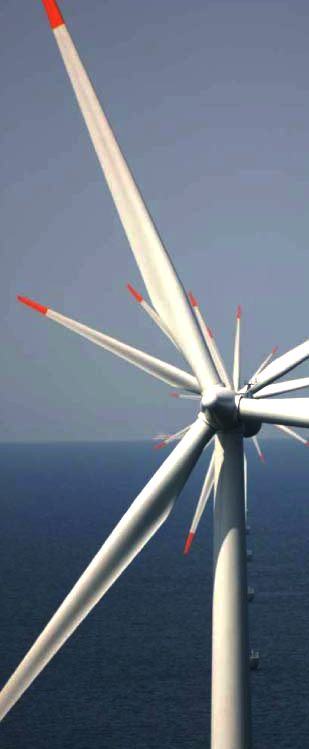
DESIGN
Offshore wind resource characteristics span a range of spatial and temporal scales and field data on external conditions. Necessary data includes water depth, currents, seabed, migration, and wave action, all of which drive mechanical and structural loading on potential turbine configurations. Other factors include marine growth, salinity, icing, and the geotechnical characteristics of the sea or lake bed. A number of things are necessary in order to attain the necessary information on these subjects. Existing hardware for these measurements includes Light Detection and Ranging (LIDAR), Sonic Detection and Ranging (SODAR), radar, autonomous underwater vehicles (AUV), and remote satellite sensing, although these technologies should be assessed and refined, according to a report from a coalition of researchers from universities, industry, and government, supported by the Atkinson Center for a Sustainable Future
Because of the previous factors, one of the biggest difficulties with offshore wind farms is the ability to predict loads. Analysis must account for the dynamic coupling between translational (surge, sway, and heave) and rotational (roll, pitch, and yaw) platform motions and turbine motions, as well as the dynamic characterization of mooring lines for floating systems. Foundations and substructures make up a large fraction of offshore wind systems, and must take into account every single one of these factors.
LEAGUE
TABLE
Europe is the world leader in offshore wind power, with the first offshore wind farm being installed in Denmark in 1991. In 2008, offshore wind power contributed 0.8 gigawatt (GW) of the total 28 GW of wind power capacity constructed that year. By October 2009, 26 offshore wind farms had been constructed in
Europe with an average rated capacity of 76 MW, and as of 2010 the United Kingdom has by far the largest capacity of offshore wind farms with 1.3 GW, more than the rest of the world combined at 1.1 GW.
The UK is followed by Denmark (854 MW), The Netherlands (249 MW), Belgium (195 MW), Sweden (164 MW), Germany (92 MW), Ireland (25 MW), Finland (26 MW) and Norway with 2.3 MW. By August 2010, the total installed capacity of offshore wind farms in European waters had reached 3 GW.
As of October 2010, Danish wind turbine manufacturers Siemens Wind Power and Vestas have installed 91.8% of the world's 3.16 GW offshore wind power capacity, although REpower is now starting to become a major player. Based on current orders, BTM expects 15 GW more between 2010 and 2014.
Projections for 2020 calculate a wind farm capacity of 150 GW in European waters which would provide 13–17% of the European Union's demand of electricity.
WORLD'S
LARGEST OFFSHORE WIND FARMS
At the end of 2011, there were 53 European offshore wind farms in waters off
Belgium, Denmark, Finland,
Germany,
Ireland, the
Netherlands,
Norway,
Sweden and the United Kingdom, with an operating capacity of 3,813 MW, while 5,603 MW is under construction. More than 100 GW (or 100, 000 MW) of offshore projects are proposed or under development in
Europe. The European Wind Energy Association has set a target of 40 GW installed by 2020 and 150 GW by 2030.
As of July 2013, the 175-turbine London Array in the United Kingdom is the largest offshore wind farm in the world with a capacity of 630MW, followed by Greater Gabbard (504MW) and Walney (367 MW), also in the United Kingdom.
There are many large offshore wind farms under construction including Anholt Offshore Wind Farm (400 MW), BARD Offshore 1 (400 MW), Lincs Wind Farm (270 MW) and Sheringham Shoal (317 MW).
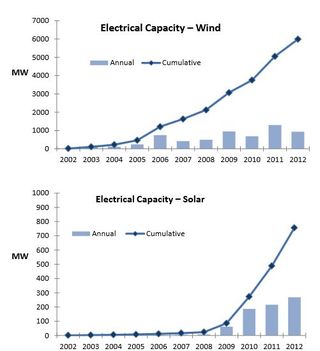
Offshore wind farms worth some €8.5 billion ($11.4 billion) were under construction in European waters in 2011. Once completed, they will represent an additional installed capacity of 2844 MW.
China has two operational offshore wind farms of 131
MW and 101 MW capacity.
The province of Ontario in Canada is pursuing several proposed locations in the Great Lakes, including the suspended Trillium Power Wind 1 approximately 20 km from shore and over 400 MW in capacity. Other Canadian projects include one on the Pacific west coast.
As of 2012, there are no offshore wind farms in the United
States. However, projects are under development in wind-rich areas of the East Coast, Great Lakes, and Pacific coast. In January 2012, a "Smart for the Start" regulatory approach was introduced, designed to expedite the siting process while incorporating strong environmental protections. Specifically, the Department of Interior approved “wind energy areas” off the coast where projects can move through the regulatory approval process more quickly.
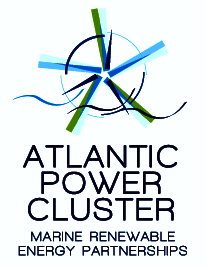
ATLANTIC
POWER CLUSTER
The
Atlantic regions have a huge potential in renewable energy which can be useful for the EU to meet the goals of its energy strategy, while contributing to the prosperity of their industries and populations, and meeting the objectives of economic, social and territorial
cohesion. The Atlantic Power Cluster project builds on the Marine Energy Working Group set up in the CPMR (Atlantic Arc Commission) and is intended to implement a transnational marine energy strategy so the partner regions can seek complementarities to tackle the crucial challenges for the development of marine energies in the Atlantic Area (AA).
The APC project seeks to develop cooperation and joint approaches to facilitate the identification of new market niches in the renewable energy sector and the redefinition of educational and training programs as per the needs of the offshore and marine energy sector in the AA. The project is likewise is expected to contribute to a "greener" model of energy development, while enhancing the competitiveness and innovation capacities in the
Atlantic regions.
APC aim to build a transnational marine energy strategy in the Atlantic Area
with a supportive political and social environment for marine energies, designed
to enhance the competitiveness and innovation capacities of the industrial community in the Atlantic regions.
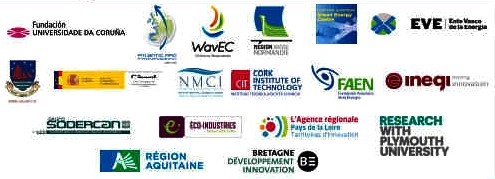
WORK MODULES
Activity 1
Project management and coordination will embrace strategic coordination (steering committee and working groups), administrative coordination and financial coordination.
Sodercan
Activity 2
Regional study on marine renewable energies will address the present situation in the partner regions from a strategic and political point of view. Understanding where the regions are will enable them to better define where they want to be in the next future.
CPMR
Activity 3
Public awareness and social acceptance is intended to develop a comprehensive methodology to increase public awareness and social acceptance of marine energy developments.
Galway County Council
Activity 4
Business development : identifying challenges of the marine energy industry in the Atlantic Area, seeking to facilitate the identification of new market opportunities in the EU offshore and marine energy sector.
Bretagne Development Innovation
Activity 5
Adapting the Atlantic Workforce to the needs of the marine energy sector will address the significant opportunities for employment creation and upgrading of skills and the significant challenges in having a highly trained workforce available to service the sector's future needs.
Cork Institute of Technology
Activity 6
Defining a marine energy cluster will build on previous activities to establish current strengths, weaknesses and capability gaps. It will also identify test sites available in the partner regions and afterwards will design cooperative structures from existing resources and complementarities, focusing on technology and project development and development of coherent region wide policies.
Scottish European Green Energy Centre
Activity 7
Communication and dissemination will be dealing with the design and implementation of a sound communication plan to ensure a proper dissemination of the project activities and project results, as well as a suitable impact at regional, national and European level.
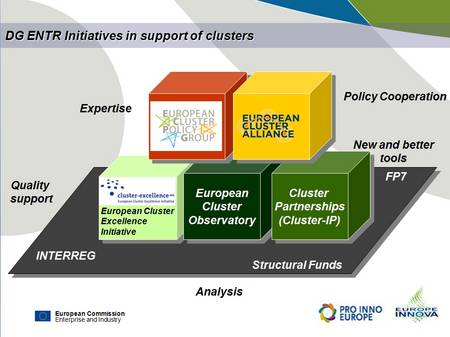
PARTNERS
1
- SODERCAN [ Spain]
2
- FUAC - Foundation University of La Coruna [Spain]
3
- Galway Countil Council [Ireland]
4
- Bretagne Developpement Innovation [France]
5
- FAEN - Asturias Energy Agency [Spain]
6
- Regional Council of Basse-Normandie [France]
7
- CPMR - Atlantic Arc Commission [France]
8
- CIT - Cort Institute of Technology [Ireland]
9
- EVE - Basque Government Energy Agency [Spain]
10
- Wave Energy Centre [Portugal]
11
- INEGI [Portugal]
12
- SEGEC - Scottish European Green Energy Centre [UK]
13
- Pole des Eco-Industries de Poitou Charentes [ France]
14
- L'Agence regionale Pays de lar Loire - Territoires d'innovation
[France]
15
- Regional Council of Aquitane [France]
16
- CIEMAT - Spanish Environment Energy Research Centre [Spain]
17
- Research with Plymouth University [UK]
|
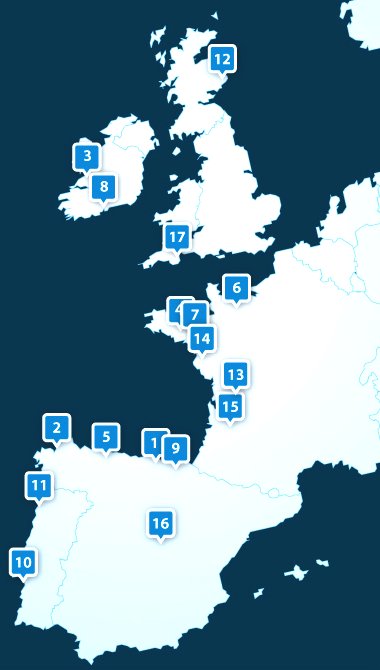
|
LINKS
& REFERENCE
Maritime
journal new most powerful wind turbine prototype Maritime
journal marine renewable energy Vestas world record breaker
Wikipedia
Megawatt
Wikipedia
Wind_farm
Wikipedia
Offshore_wind_power
http://www.mhivestasoffshore.com/Products-and-services/The-Turbines/V164
http://en.wikipedia.org/wiki/Megawatt
http://en.wikipedia.org/wiki/Wind_farm
http://en.wikipedia.org/wiki/Offshore_wind_power
http://en.wikipedia.org/wiki/Naval_Oceanographic_Office
http://en.wikipedia.org/wiki/United_Kingdom_Hydrographic_Office http://www.ths.org.uk http://www.renewableenergyworld-events.com/register.html http://www.maritimejournal.com/news101/industry-news/new-most-powerful-wind-turbine-prototype
http://www.maritimejournal.com/news101/marine-renewable-energy/mhi-vestas-record-breaker2
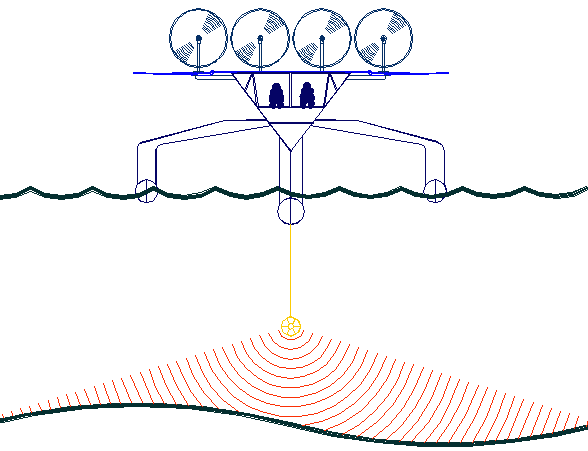
PATENT
PENDING - The
key to accurate hydrographic mapping is continuous monitoring,
for which the Bluefish SNAV
platform, presently under development, is a robotic ocean workhorse. Based on a stable
SWASH
hull this design is under development in the UK, looking to expand into
the US. The robot
ship uses no diesel fuel to monitor the oceans autonomously (COLREGS
compliant) at relatively high
speed 24/7 and 365 days a year - only possible with the revolutionary (patent) energy harvesting system. The
hullform is ideal for automatic release and recovery of ROVs
or towed arrays, alternating between drone and fully autonomous modes.
International development enquiries are welcome. This vessel
pays for itself in fuel saved every ten years.
|










